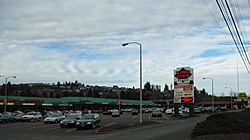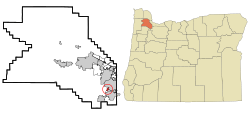King City, Oregon facts for kids
Quick facts for kids
King City, Oregon
|
|
|---|---|

Strip mall on 99W
|
|

Location in Oregon
|
|
| Country | United States |
| State | Oregon |
| County | Washington |
| Incorporated | 1966 |
| Area | |
| • Total | 0.81 sq mi (2.10 km2) |
| • Land | 0.81 sq mi (2.10 km2) |
| • Water | 0.00 sq mi (0.00 km2) |
| Elevation | 180 ft (50 m) |
| Population
(2020)
|
|
| • Total | 5,184 |
| • Density | 6,392.11/sq mi (2,467.36/km2) |
| Time zone | UTC-8 (Pacific) |
| • Summer (DST) | UTC-7 (Pacific) |
| ZIP code |
97224
|
| Area code(s) | 503 and 971 |
| FIPS code | 41-39150 |
| GNIS feature ID | 2411545 |
| Website | www.ci.king-city.or.us |
King City is a city in Washington County, Oregon, United States. Its name was picked by the Tualatin Development Company, Inc., which used a royalty theme in naming the city streets. The population was 5,184 at the 2020 census. Fire protection and EMS services are provided through Tualatin Valley Fire and Rescue.
Contents
History
The community was built by the Tualatin Development Company starting in 1964. Created as a planned community for adults, King City was incorporated in March 1966. Build-out of the original 273 acres (110 ha) finished about 1978. Originally, King City was developed as an age-restricted community governed by the rules of the King City Civic Association (KCCA) in which people under 50 could not live in the city.
The KCCA rules were later changed to conform to the 1988 amendments to the Federal Fair Housing Act, which set the age restriction to 55 or older. Later, the city, which was at first contiguous with the boundaries of KCCA, expanded to include newer, non-age restricted developments. Future expansion to the west is planned for the city, within the limits of the Portland Metropolitan Urban Growth Boundary. In 2024, the City Council passed an annexation on the far West side of the King City Urban Growth Boundary. This annexation was approved by 100% of land owners and increased the City land area by approximately 215 acres.
Geography
According to the United States Census Bureau, the city has a total area of 0.72 square miles (1.86 km2), all of it land.
Demographics
| Historical population | |||
|---|---|---|---|
| Census | Pop. | %± | |
| 1970 | 1,427 | — | |
| 1980 | 1,853 | 29.9% | |
| 1990 | 2,060 | 11.2% | |
| 2000 | 1,949 | −5.4% | |
| 2010 | 3,111 | 59.6% | |
| 2020 | 5,184 | 66.6% | |
| U.S. Decennial Census | |||
2010 census
As of the census of 2010, there were 3,111 people, 1,735 households, and 729 families living in the city. The population density was 4,320.8 inhabitants per square mile (1,668.3/km2). There were 1,920 housing units at an average density of 2,666.7 per square mile (1,029.6/km2). The racial makeup of the city was 89.0% White, 1.8% African American, 0.4% Native American, 5.2% Asian, 0.3% Pacific Islander, 1.3% from other races, and 2.1% from two or more races. Hispanic or Latino of any race were 4.5% of the population.
There were 1,735 households, of which 12.0% had children under the age of 18 living with them, 34.2% were married couples living together, 6.2% had a female householder with no husband present, 1.6% had a male householder with no wife present, and 58.0% were non-families. 54.1% of all households were made up of individuals, and 43.7% had someone living alone who was 65 years of age or older. The average household size was 1.75 and the average family size was 2.63.
The median age in the city was 63.9 years. 13% of residents were under the age of 18; 2.3% were between the ages of 18 and 24; 15.4% were from 25 to 44; 21.4% were from 45 to 64; and 48% were 65 years of age or older. The gender makeup of the city was 38.2% male and 61.8% female.
See also
 In Spanish: King City (Oregón) para niños
In Spanish: King City (Oregón) para niños


